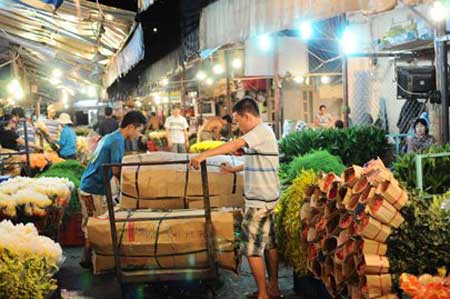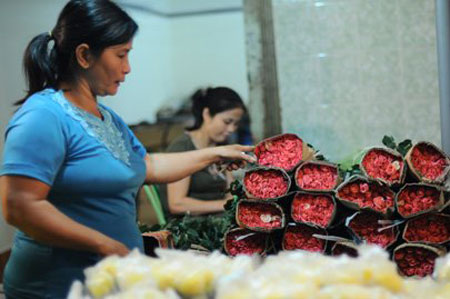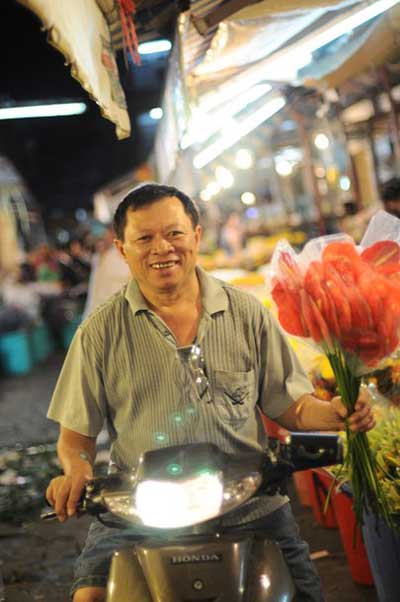TRAVEL ESSENTIALS
WHY GO NOW?
The dry season in the southern portion of Vietnam runs from December to April, making now the ideal time to visit the country's biggest metropolis. The city will also be in party mode on 30 April. Liberation Day celebrates the anniversary of the end of the American War and the reunification of the two halves of Vietnam in 1975.
WHY GO NOW?
The dry season in the southern portion of Vietnam runs from December to April, making now the ideal time to visit the country's biggest metropolis. The city will also be in party mode on 30 April. Liberation Day celebrates the anniversary of the end of the American War and the reunification of the two halves of Vietnam in 1975.

TOUCH DOWN
Tan Son Nhat airport sits 7km north-west of the centre of the city.
Transfers will be included if you are on a wider tour. Taxi firm Mai Linh has a booth in the arrivals hall. Cabs to the centre cost 200,000 Vietnamese dong (NZ$11.40), taking 15 to 30 minutes. Bus 152 runs to the main bus station on Tran Hung Dao street, for V$5000 (29c), during daylight hours.
GET YOUR BEARINGS
Although it has borne its official name for almost 40 years since Vietnamese reunification (it was the capital of the anti-communist, American-supported South Vietnam), Ho Chi Minh City is still largely referred to by locals as Saigon.
It straddles the Saigon River in the south of the country, north-east of the Mekong Delta. It is split into 24 districts, but District One the core of the French colonial city of the 19th century holds the key sights.
Taxis are the easiest method of transport Mai Linh (green and white livery) or Vinasun Taxi and far safer than the informal motorbike rides (xe om) that can be hailed. The centre can also be covered on foot. There is no tourist office but is a solid resource.
DAY ONE
TAKE A HIKE
Begin outside the Reunification Palace at 135 Nam Ky Khoi Nghia. This concrete giant, the former presidential palace of South Vietnam, witnessed the symbolic end of the war on 30 April 1975 when a phalanx of North Vietnamese tanks smashed down its gates. It is now a museum (open daily 7.30-11am and 1-4pm. Its echoing interior is all Cold War phones, map rooms and reinforced bomb shelters.
From here, stroll two blocks north-east along Le Duan, a leafy colonial boulevard. Turn right into Cong Xa Paris square and pass the red-brick cathedral of Notre-Dame de Saigon before entering the Central Post Office, another splendid French leftover (open daily 6am-10pm).
WINDOW SHOPPING
If you leave the square at its south-east end, you arrive on to Dong Khoi, one of the city's key drags. Among the jewellery and fashion stores, you'll find the mega-mall of Parkson Plaza, just off the avenue at 41-45 Le Thanh Ton. Diamond Plaza, at 34 Le Duan, does similar retail modernity, but there's a far more traditional vibe to Ben Thanh Market for Vietnam tourism, a cluttered pocket of stalls, where you can buy everything from fruit to T-shirts.
LUNCH ON THE RUN
Pop into Pho 24 at 71-73 Dong Khoi where pho bo (the national dish of beef with noodles) is V$49,000.
CULTURAL AFTERNOON
The War Remnants Museum at 28 Vo Van Tan, traces what happened to Vietnam during its turbulent 20th century. Perspective is unsurprisingly one-eyed, but the bleakness cuts through the bias. US tanks and helicopters are lined up outside.
Next to the river at 1 Nguyen Tat Thanh, the Ho Chi Minh Museum focuses on the man whose vision helped wrest Vietnam from foreign control. Open daily except Monday, 8-11.30am and 2-5pm (V$10,000), it has a limited collection of personal artefacts.

For more depth, try the Vietnam History Museum at 2 Nguyen Binh Khiem, which dissects Vietnam's rich heritage back to the ancient Cham civilisation.
DINING WITH THE LOCALS
Lemongrass, a colourful Vietnamese option at 4 Nguyen Thiep, puts the emphasis on seafood, with mains from V$100,000. Le Jardin dreams of the French era with steaks in a garden setting at 31 Thai Van Lung. Meanwhile, Xu at 71-75 Hai Ba Trung, pushes local cuisine into the 21st century.
DAY TWO
SUNDAY MORNING: GO TO CHURCH
Notre-Dame de Saigon is so French that during its construction (1863-1880), every stone slab was came from Marseille. Open daily 8am-5pm (Sunday mass at 9.30am), it provides a calm presence at 1 Cong Xa Paris, its twin towers rear 58m above the square.
Of course, Vietnam is largely Buddhist, and the city provides another major religious site in the Xa Loi Pagoda. There is no special beauty to this compound at 89 Ba Huyen Thanh Quan (open daily 6-11.30am and 2-9pm), aside from its six-tier bell tower and the shrine to Thich Quang Duc, a monk whose suicide protest by self-immolation was captured by news cameras and became one of the 20th-century's most striking images. It took place four blocks south of the pagoda at Cach Mang Thang Tam and Nguyen Dinh Chieu.

A WALK IN THE PARK
North of the immediate centre, the Botanical Gardens at 2b Nguyen Binh Khiem were another French gift. Part of the Saigon Zoo complex, this verdant space is open daily 7am-7pm, admission V$12,000. Dating to 1864, its tree-shaded lanes, where young couples stroll, could almost be Paris but for the tropical foliage and chirp of insects.
OUT TO BRUNCH
A reflection of the city's increasingly international make-up, The Sushi Bar at 2 Le Thanh Ton deals in fresh Japanese fare.
TAKE A VIEW
The city's future as a business hot spot is most discernible in the 263m Bitexco Financial Tower, near the waterfront at 2 Hai Trieu. This vision in glass looks like a fragment of Dubai. Its 49th-floor observation deck opens 9.30am-9.30pm except Friday and Saturday, 10am-10pm, entry V$200,000. The view highlights the fast-evolving metropolis west of the river and the predominantly undeveloped east bank.
ICING ON THE CAKE
The Rex Hotel at 141 Nguyen Hue was the site of regular press briefings as the war turned against the United States. Weary reporters came to know these dispatches infused with a growing self-denial as "Five O'Clock Follies''. These words now flash in neon above the hotel's fifth-floor Rooftop Garden bar where you can enjoy a ginger mojito for V$160,000 and absorb the city's ceaseless ebb and flow from an outdoor seat.


 A man smiles happily after buying a beautiful boutique of flamingo flowers.
A man smiles happily after buying a beautiful boutique of flamingo flowers.